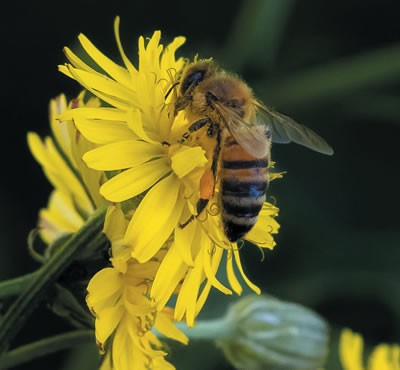
Mirrihue Alto is a rural town located a little more than three miles from the village of Antuco in the Bio-Bio region of southern Chile. Some of its inhabitants work in honey and honey-derived products.
One of the major challenges facing the area is the lack of native trees and wild flora, primarily due to the proliferation of large monoculture plantations, such as pine and eucalyptus. Trees like eucalyptus can consume between five gallons of water per day for a three-year-old tree and up to 53 gallons of water for a 20-year-old tree, which damages the ecosystem and renders these hectares highly vulnerable to forest fires. Furthermore, pine trees cause significant harm to the soil and subsequently to the ecosystem of other wildlife. Water scarcity is one reason it’s difficult to maintain and support native trees and wild flora, leading to the need for assistance, such as deep wells for irrigation, which helps create floral diversity. Additionally, monoculture directly impacts the lives of bees, pollination, honey production, and its byproducts, influencing the area’s wildlife.
That’s why, years ago, when I discovered the area, I began dreaming of digging a deep well to plant native trees that would directly benefit the local ecosystem. It has been a long and complex journey, because the soil there is very rocky. And, the water is very deep underground which makes well construction quite expensive. Over these years of waiting and searching, a satellite survey revealed that the land where I wanted to dig was unsuitable. This result, although discouraging, didn’t deter me from dreaming and continuing my search. A few months ago, a small company informed me they could drill the well, so we resumed the hunt for a suitable location. The search for water was carried out using an ancient technique of the local Mapuche people: they used wooden rods and now employ pieces of copper wire. This method of searching for the “eye of water,” or the location of deep water, is called “zahorí.” With this technique, we identified the perfect spot to dig and create the well that would provide the water.
I must admit I was scared of the investment, but with the help of a few friends, I was able to proceed with the expenses. However, the confident man assured me that the water was 36 feet deep. His calm voice encouraged me to take the risk, even though I hadn’t first said a prayer or sprinkled holy water, nor brought a medal of Saint Pius or the Virgin Mary to the chosen spot. The initial feet of digging were challenging and filled with rocks. While we were digging and only encountering rock, a local man—since digging a well is a community effort where all the neighbors help—asked me if I had sought Mother Earth’s permission to dig and draw water.
This question, “Did you ask Mother Earth’s permission to dig and draw water?” lingered in my mind, and early the next day, I returned to the site to pray once more. I sprinkled holy water and sought Mother Earth’s permission to continue digging for water. The ground began to give way, and soon, water gushed from the depths of the earth at 30 feet. By 43 feet, a steady flow was ensured for the trees that will be planted this winter in southern Chile. These native trees will be donated by those who have learned about this wish to contribute to biodiversity.
This experience teaches me to continue searching even when the “studies” are unfavorable; it encourages me to trust the dream that drives my search. It reveals the wisdom in “asking permission,” which implies recognizing our interconnectedness rather than seeing ourselves as owners of Mother Earth, or “Ñuke Mapu” in the language of the Mapuche people. It reminds me to trust what others share (small business, the man with the copper rods, the neighbor who came to accompany me) and urges me to delve deeper, motivating me to remove the obstacles. It is arduous work, but one that enables an encounter with life: water!
A native of Chile, Columban Fr. Alvaro Martinez now lives and works in the U.S.